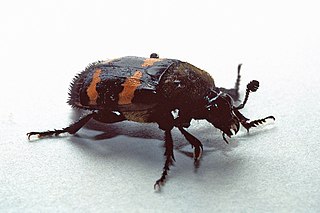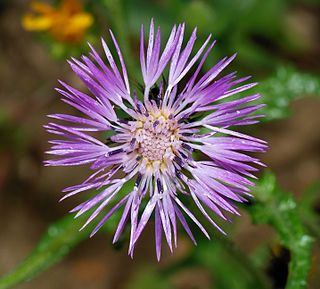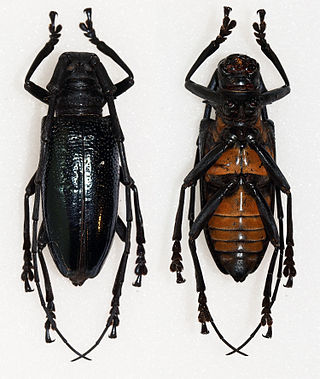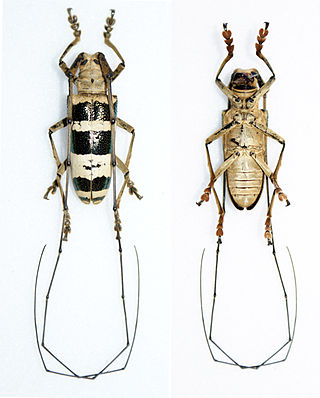Related Research Articles

The woolly giant rat is a species of large burrowing rodent native to South America. No subspecies are currently recognised. It is the only member of the genus Kunsia.

Nicrophorus tomentosus is a species of burying beetle that was described by Friedrich Weber in 1801. The beetle belongs to the family Silphidae which are carrion beetles. The beetles have sensitive antennae that contain olfactory organs. Thus, the beetle can locate dead animals (carcass), and then as the name suggests, can bury them. However, unlike other burying beetles, N. tomentosus does not completely bury these brood carcasses. They instead dig a shallow hole under the carcass and cover it with leaf litter. Recognition of these beetles can be distinguished by its black color with orange markings on the wing covers (elytra).

Ceanothus tomentosus, with the common name woollyleaf ceanothus, is a species of shrub in the family Rhamnaceae. It is characterized by pale-blue to deep blue flowers and wooly leaves. It is native to California and Baja California, having an unusual disjunct distribution in the Peninsular Ranges and the north-central Sierra Nevada.

Suillus tomentosus is a species of mushroom. The common names of the species are blue-staining slippery jack, poor man's slippery Jack, and woolly-capped suillus.

Alectryon tomentosus, commonly known as the hairy birds eye, red jacket or woolly rambutan, is a rainforest tree of the family Sapindaceae found in eastern Australia. The specific epithet tomentosus refers to the hairy leaves and hairy young shoots.

Acmispon is a genus of flowering plant in the family Fabaceae (legumes), native to North America and the west coast of Chile in South America. It includes several species of American bird's-foot trefoils and deervetches formerly contained in the globally distributed genus Lotus. The former genus Syrmatium is included in Acmispon. The Jepson eFlora accepts only Acmispon.

Galactites tomentosus, the purple milk thistle, is a biennial herbaceous plant belonging to the genus Galactites of the Asteraceae family.

Acreichthys tomentosus, commonly known as the bristle-tail filefish or Aiptasia-eating filefish, is a species of demersal marine fish which belongs to the family Monacanthidae and is widespread throughout the tropical waters of the Indo-west Pacific. It is a small fish that can reach a maximum size of 12 cm (4.7 in) length and has the ability to rapidly change color and skin texture and patterns as to avoid detection and consequently predation. It is oviparous.
Ellipanthus tomentosus is a plant in the family Connaraceae. The specific epithet tomentosus is from the Latin meaning "thickly covered with hairs", referring to the leaves.
Nemophas ammiralis is a species of beetle in the family Cerambycidae. It was described by Bernhard Schwarzer in 1931.
Nemophas bennigseni is a species of beetle in the family Cerambycidae. It was described by Per Olof Christopher Aurivillius in 1908. It is known from Papua New Guinea.

Nemophas cyanescens is a species of beetle in the family Cerambycidae. It was described by Karl Jordan in 1898. It is known from Moluccas.
Nemophas grayii is a species of beetle in the family Cerambycidae. It was described by Francis Polkinghorne Pascoe in 1859, originally under the genus Monohammus. It is known from Moluccas.

Nemophas incensus is a species of beetle in the family Cerambycidae. It was described by Francis Polkinghorne Pascoe in 1866. It is known from Moluccas.
Nemophas leuciscus is a species of beetle in the family Cerambycidae. It was described by Francis Polkinghorne Pascoe in 1866. It is known from Moluccas.

Nemophas ramosi is a species of beetle in the family Cerambycidae. It was described by Schultze in 1920, originally as a subspecies of Nemophas rosenbergii. It is known from the Philippines.

Nemophas rosenbergii is a species of beetle in the family Cerambycidae. It was described by Coenraad Ritsema in 1881. It is known from Sulawesi.

Nemophas subterrubens is a species of beetle in the family Cerambycidae. It was described by Heller in 1924. It is known from the Philippines.
Nemophas sumbaensis is a species of beetle in the family Cerambycidae. It was described by Vitali in 2013. It is known from Indonesia.
Nemophas zonatus is a species of beetle in the family Cerambycidae. It was described by Lansberge in 1880. It is known from Indonesia.
References
- ↑ BioLib.cz - Nemophas tomentosus. Retrieved on 8 September 2014.